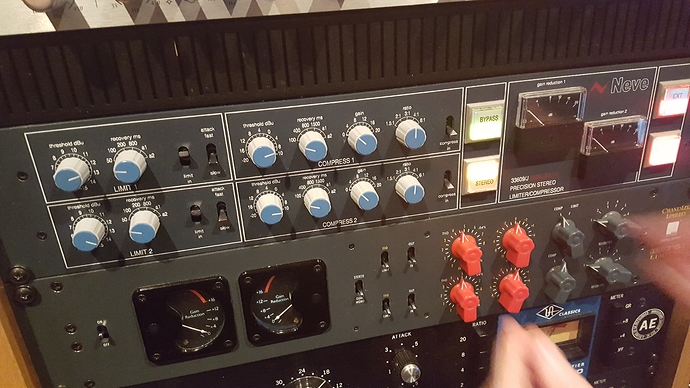So the 33609 is a diode bridge compressor that’s great on a 2 bus and similar in Vibe to the Focusrite Red 3 in that it compresses gently without digging. On the rare occasions where I track in a large studio, I love to use it on orchestras and choirs. Here (in the picture below) are the settings I typical start with for 2 bus use. All the studios I track film scores at have at least one of these. All of them also have SSL 9000J’s. When we were screwing around after the sessions were over, I was able to pick the 33609 apart from the SSL bus comp pretty consistently on a digitally level matched, bounced/printed blind test in the actual control room.
Again, when I use this on the 2 bus, its never pop or rock. Its always either film scores, musical theater stuff, or church choirs.
I don’t use the T-racks but I use the UAD version of the Vari-Mu regularly. I shouldn’t say regularly because I’m hardly recording any music these days. But I when I did it was a go-to. So the Vari-Mu is a modernized offshoot of the Fairchild. Same type of circuit. The signature sound is created by the internal tubes re-biasing on a timed basis. The tubes re-bias automatically according to the program information (volume and frequency content) of the incoming audio source.
A super layman way of thinking about this compressor is that it self-adapts to whatever it hears.
What this means is it doesn’t create the slam and punch of an 1176 or distressor. It gives you a smooth, super transparent, and highly controlled ‘feel’ of compression. This is because the mechanism that causes it to compress reacts to program information ‘slower’. An 1176 and Distressor can be slowed down, but when they slow down, they don’t sound the same. I use the Vari-Mu on southern gospel vocals, opera singers, broadway style vocalists, acoustic pianos, and pipe organs. Where you want the compression to sound almost unprocessed. I don’t ever use this to control dynamics. In my opinion there are much better compressors than a Vari-Mu which can be placed infront in order to achieve the same level of transparency. The Vari-Mu is NOT a leveling amp. If you want a transparent leveling amp, but one that’s uber transparent, the 33609 can actually do this because of its Dual Stage design. Same with the Shadow Hills Mastering Comrpessor. (The 33609 has a comp stage/limit stage, the Shadow Hills has a opti/discrete stage)
So for dynamic control with grit, edge, character, and dirt. 1176 ->LA2A or Distressor -> LA2A for me. For Transparency 33609 -> VariMu/Fairchild or Shadow Hills->VariMu/Fairchild. Chandler Limited comps also fall into this category.
Your half-way-in-between compressor might be your API2500 or TubeTech CL1B. Other option are a Summit Audio or Elysia which have accurate models available as plugins.
Hey @Tesgin… we talked about some of this stuff a while back. Thought you might find some of this dialogue helpful - I know you like to sort of classify and categorize how things function and organize 



